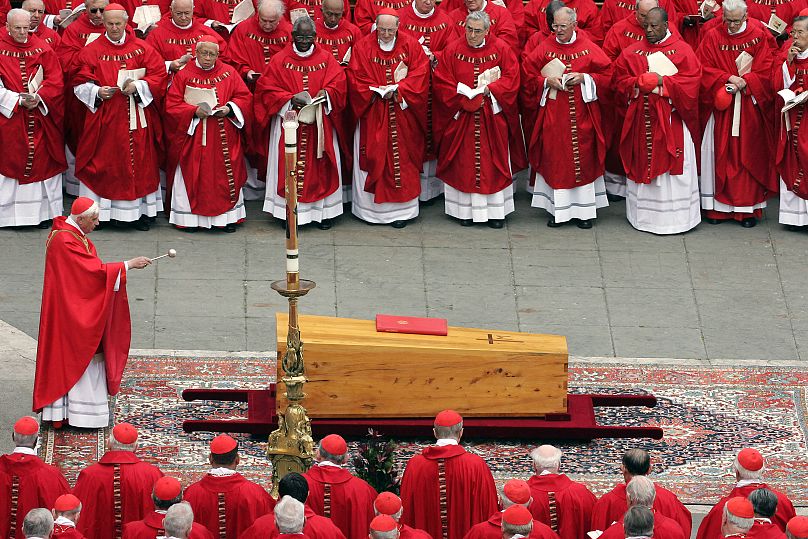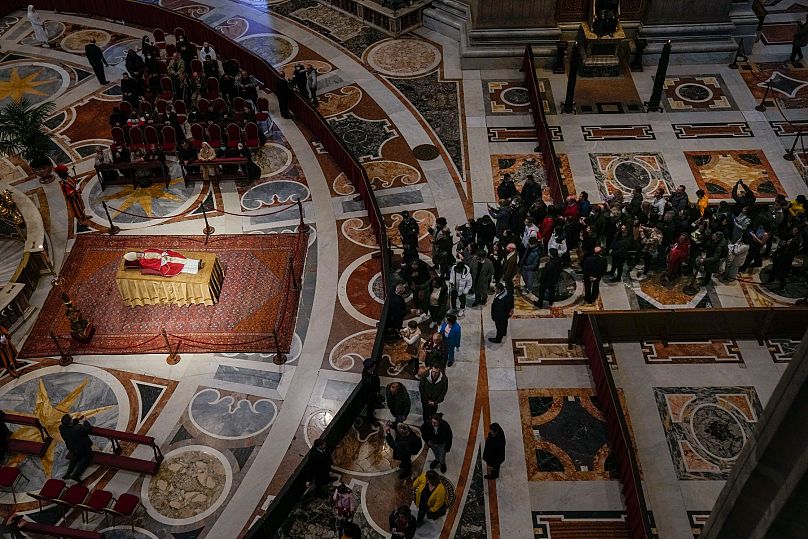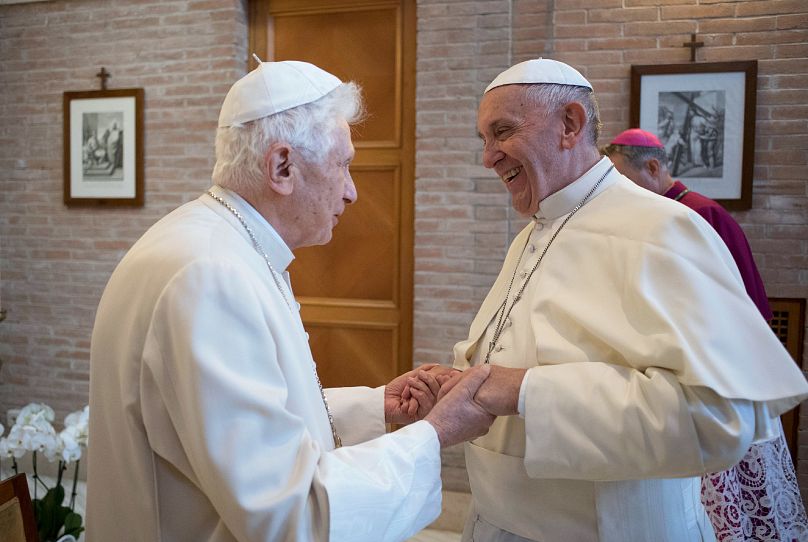The ceremony will be the first of its kind, as the Vatican has never had to bury a pope while another, reigning pope was still living.
When Pope Benedict XVI announced he was retiring on 11 February 2013 -- the first pope to do so in 600 years -- he did so in Latin, in the presence of a small group of journalists.
- Ad cognitionem certam perveni vires meas ingravescente aetate non iam aptas esse ad munus Petrinum aeque administrandum.
Giovanna Chirri, the Vatican correspondent for the Italian news agency ANSA, began to shake upon hearing the announcement. She could not believe what she had just heard: "I have come to the certainty that my strength, due to my advanced age, is no longer adequate to properly exercise the Petrine ministry."
Chirri's knowledge of Latin is what gave her a world exclusive on the historic news. She broke the story of her life. German theologian Joseph Ratzinger was retiring from his role as pope, a move that was as unexpected as it was unheard of.
Ratzinger lived ten more years in the Mater Ecclesia Monastery in the Vatican as Pope emeritus, most of which he spent hidden away from public view. After his death on 31 December, the Catholic Church now has to face another unprecedented situation: how to bury a retired pope?
Euronews has interviewed José Manuel Vidal, a Spanish Vatican member and director of "Religión Digital", an online platform offering religious news in Spanish, to better understand the keys to a historic funeral.
What can we expect from Benedict XVI's funeral?
The Catholic Church follows a strict protocol every time a pope dies, leading to the conclave, the gathering of cardinals in the Sistine Chapel to designate his successor.
It is a "spectacular event, like everything that is done in Rome, with a fabulous setting such as Saint Peter's Square, in the shape of a heart, welcoming kings, presidents, prime ministers, and crowds of people within a wonderful setting, where every little detail is taken care of", explains Vidal.
The last funeral of a pope was that of John Paul II, on 2 April 2005. It brought together nearly 300,000 people around Saint Peter's Square.
Vidal says that we can expect similar images in the farewell to Benedict XVI.
According to data released by the Vatican Gendarmerie on Tuesday, more than 60,000 pilgrims have already approached Saint Peter's Basilica where Ratzinger's body is located.
How is it going to be different from the funeral of a reigning pope?
In the case of Ratzinger's funeral, there are two things to consider: the first, is that he died as pope -- emeritus, but always pope -- but not as head of state of Vatican City.
"It is not a state funeral, because the pope who has died is not the reigning pope and therefore it cannot be a state funeral," says Vidal.
The second differentiating factor is that another pope, Francis -- the reigning pope with whom Benedict shared the title for the last decade of his retiring papacy -- will preside over the funeral for the first time in history.
"In Benedict's case there is no vacant seat, which is why all the cardinals are not necessarily summoned to Rome," adds Vidal. "There is no meeting of cardinals, there is no conclave and, therefore, the one presiding over the funeral is the reigning Pope."
Who's going to attend the ceremony?
Only the Italian and German delegations have been officially invited.
Vatican spokesman Matteo Burni has specified that "if other heads of state or government come, they will do so in a personal capacity."
But Vidal believes that this is not going to stop many other personalities from attending the funeral of the first retired pope.
Among the confirmed attendees are the President of Poland Andrzej Duda; King Philippe of Belgium; Sophia, the Spanish Queen Mother, accompanied by a group of high prelates from the Spanish Episcopal Conference; the President of Portugal Marcelo Rebelo de Sousa; and a delegation from the Orthodox Patriarchate of Constantinople.
Has any other pope resigned before Benedict XVI?
"After having repeatedly examined my conscience before God, I came to the certainty that my strength, due to advanced age, is no longer suitable for an adequate exercise of the Petrine ministry," Ratzinger explained in the 2013 statement announcing his resignation.
"I am well aware that this ministry, due to its essential spiritual nature, must be carried out not only by word and deed, but also by prayer and suffering."
The announcement was a rare one for the Vatican.
Before Benedict XVI, there are only Celestine V, who famously resigned in 1294 -- the same year of his election -- and Gregory XII, who left the Petrine ministry in 1415, in the midst of one of the biggest schisms of the Catholic Church.
All in all, we have to go back more than 600 years to find a similar situation to the one facing the Vatican now -- too many to find inspiration for the funeral of Benedict XVI, according to Vidal.
But he doesn't think it will take centuries to repeat itself.
"Resigning, like Pope Benedict XVI did, is potentially going to become something of a habit, something that more popes are going to do," explains Vidal. "In fact, Pope Francis has already submitted his resignation in case of serious impediment."
What did Pope Benedict want for his funeral?
Solemn, but at the same time sober. This is how Benedict said that he wanted it his farewell to be.
"It matches his personality," explains Vidal. "He gave great importance to the rituals, the liturgy, the ornaments [of the Catholic tradition]. We saw with him ornaments that in modern times had never been used by any Pope. He took care of the liturgy with care."
What power of decision does Pope Francis have?
The last word on the ceremony is held by Pope Francis.
"But that is first discussed by the ceremony team led by Monsignor (Giovanni) Ravelli," says Vidal.
"Then the last step is Pope Francis, who has requested -- and some of his collaborators have confirmed so -- to offer Pope Benedict a burial in style. That is, not of State, but almost of State and so with the highest solemnity."
How were the last years of Benedict?
His resignation prompted calls to establish rules and regulations for future retired popes, so as to avoid the kind of confusion that ensued from Benedict XVI's resignation.
The two popes lived side by side in the Vatican gardens, an unprecedented arrangement that has laid the groundwork for future "popes emeritus" to do the same.
"Some are even thinking about creating a statute for the pope emeritus, to see how it is going to be legally received canonically, with all the details, which might mean [...] that from now on there may be other burials and other emeritus popes", explains Vidal.
This would entail, in addition to establishing a specific protocol for his funeral, regulating details such as whether the emeritus pope can continue to be called Benedict, hold his position as pope or wear white. In addition to whether he has to continue living in the Vatican or can go live somewhere else.
"It sets precedents and will set more and more precedents, including whether in the role of pope emeritus, this will have the right to intervene in the life of the Church once he retires."
What will Benedict XVI be remembered for?
The German theologian will be remembered as the first pope in 600 years to resign.
"But it will also go down in history for the miracle of communion that Pope Benedict and Pope Francis achieved," adds Vidal.
"In the Church, there is one thing that is terrifying, and it is the possibility of a schism, of the rupture of communion. And although in the Church -- as in any other institution or political party -- they do not like to speak In these terms, there is a conservative wing, a conservative soul, a conservative sensibility, and a progressive sensibility, both of which have been able to achieve a transition from a time of involution, from a time of a Church that was very centred on itself, coiled, very elusive, to the great spring of the Vatican".
Spanish journalist Rafael Narbona wrote on Twitter that Benedict XVI was "a pope with lights and shadows. He was a human being and it could not be otherwise." Narbona mentions that during his time as reigning pope, Benedict XVI made comments on Islam and homosexuality "were not up to the times" and left "frustration and sadness in many hearts."
Narbona also writes that Benedict XVI condemned euthanasia and abortion, though he considered the death penalty and war acceptable in some cases.














